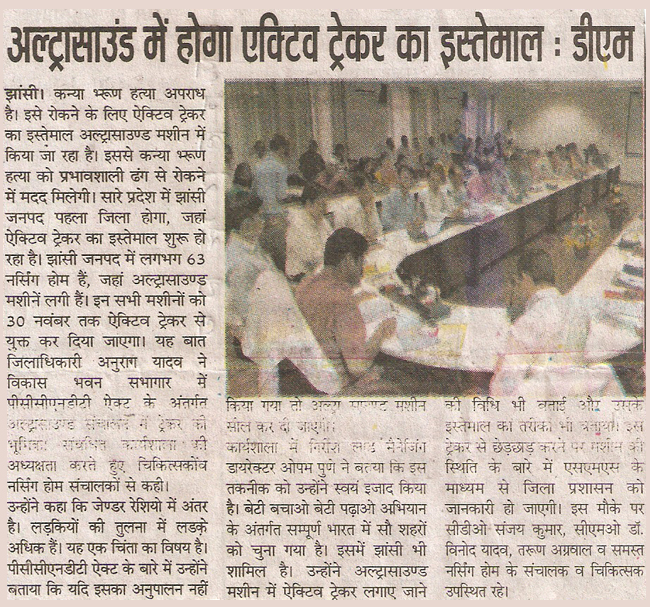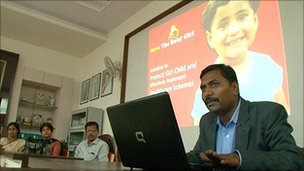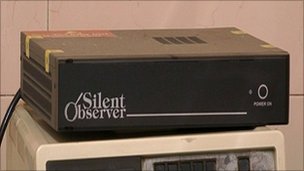| |
-
19 November 2015 Active Tracker will keep watch on female feticide (Janseva Mail)Open or Close
-
19 November 2015 Ultrasound machines on radar of dist. administration (Jan JanJagran)Open or Close
-
19 November 2015 Killing fetus in pregnancy is sin and crime: Anurag (BPN Times) Open or Close
-
19 November 2015 Female feticide will not happen (Amar Ujala)Open or Close
-
19 November 2015 The use of Active Tracker in Ultrasound machines would start from Jhansi: DM (Dainik Vishwa Samachar) Open or Close
-
19 November 2015 Active Tracker will put curb on killing of fetus (Hindustan)Open or Close
-
19 November 2015 Active Trackers will be used in Ultrasound: DM (Mahanagar Royal )Open or Close

-
19 November 2015 Now active tracker will catch the play of killing of fetus (Janata Union)Open or Close
-
19 November 2015 To prevent female feticide Active Trackers will be used in Ultrasound machines: DM (Rashtriya Sahara)Open or Close
-
19 November 2015 Population of girls being less than boys is a matter of serious concern: DM (Aaj) Open or Close
-
19 November 2015 District Administration is all set to prevent female feticide (Rashtrabodh) Open or Close
-
19 November 2015 District Collector,Jhansi,Health Officials and Doctors at workshop (Rashtriya Sahara Photo) Open or Close
-
3 August 2010 Silent ObserverTM helps Maharashtra district fight female foeticide - Published in (Times Of India) Open or Close
-
19 March 2010 STBG news in Asia's Leading Portal on E-Governance Magazine Open or Close
-
24 February 2010 Dr. APJ Abdul Kalam appriciate Save The Baby GirlTM project - Published in (Sakal, Loksatta) Open or Close
-
2 February 2010 Save the Baby GirlTM website bags Nasscom award - Published in (DNA)Open or Close
Save the baby girlTM, the website developed by district administration to stop abortion of baby girl, has been given the best website award by Nasscom, a press release from the Collector's office said.
On February 9, the award will be presented in Mumbai to Collector Laxmikant Deshmukh. In Kolhapur district, the birth rate of girl child was decreasing. To create awareness at administrative level for strict implementation of law, Collector Deshmukh put forth the concept of the website and Magnum OpusTM company developed the website.
All the sonography centres in the district are linked together to this website. Hence all information at sonography centres is available to administration and it is made compulsory to update the information on day to day basis for sonography centres.
From the last four months it is observed that there is an increase in the birth rate of girl child. Nasscom Foundation gives awards to three best websites at goveronment-level.This year, the awards are given to West Bengal, UP and Maharashtra. Save the baby girlTM website is awarded for controlling female foeticides, the social issue.
-
10 February 2010 STBG won NASSCOM award Open or Close
-
1 January 2010 STBG Portal LaunchedOpen or Close
The new version of SaveTheBabyGirlTM (STBG) is launched on 1st Jan 2010. The new version has a dashboard feature for all the centers, district administrator and tahesil administrator. This gives you the facility to view the summary at glance. The new version has also being made more attractive and pleasent. We wish to get the same support from you all. Team STBG Magnum OpusTM
-
1 September 2010 Indian state tries to save unborn - Published in (BBC News)Open or Close
A pregnant woman waits to see the tiny outline of her unborn baby on an ultrasound screen. Hanging on the wall next to her is a board that reads: "Disclosure of sex of foetus is prohibited." In India, this mum-to-be will not know the gender of her baby until the moment it is born. In places such as Kolhapur, Maharashtra, the reason for this is simple: authorities are worried that if a family finds out it is a girl, they may terminate the pregnancy. The United Nations Population Fund claims that between 2001 and 2007,pre-natal sex selection, or female foeticide, |
|
 |
Indian authorities are concerned
about female foeticide |
|
resulted in the disappearance of 1,600 girls across India every day. |
|
| Saving girls |
A six-hour drive from Mumbai, the capital of Maharashtra, Kolhapur is the centre of the state's fight against the killing of unborn girls. India's last national census in 2001 left the region with a record most locals are far from proud of. Official figures suggest it has the worst male-to-female birth ratio in Maharashtra. For every 1,000 boys that are born, there are only 829 girls. Local gynaecologist Dr Satish Pakti says that birth registration, migration and a change in economic circumstances could have some impact on the ratio. But he and local authorities firmly believe that the main |
|
 |
| Dr. Satish Patki conducts a routine ultrasound on a pregnant woman |
|
reason Kolhapur's is so skewed is female foeticide, the act of terminating a pregnancy before it reaches full-term. |
|
Panhala is a semi-urban district of Kolhapur. It has a population of 264,000 people. It also has a birth ratio that is worse than the state average. According to 2001 census figures, for every 1,000 boys that delivered and officially registered in Panhala, there are only 729 girls. For decades, authorities here say they have been fighting a losing battle. They admit they have been unable to save thousands of female foetuses from death. However, they are also convinced that something needs to be done before the absence of girls is felt by local communities, workplaces and India's rapidly growing economy. |
|
| Socially smart business |
Female foeticide is a nationwide problem, it does not discriminate. It is taking a toll on semi-urban towns where the roads are choked with peak-time traffic and markets put on a daily, colourful, show. It is also hurting small village communities such as those that call the lush, fertile plains of Kolhapur home. India's rich and poor have struggled to curb pre-natal sex selection for generations. Traditionally, families across the country have preferred boys, as they are seen as more able to provide financial stability. Moreover, when girls |
|
 |
| Girish Lad says the project is cost-effective |
|
marry, families often have to pay huge, and costly, dowries. Experts say technology and money are also exacerbating the problem. They say female foeticide is being compounded by readily available, and relatively inexpensive, ultrasound technology and the increasing wealth of India's middle class. |
|
Now, in an effort to fight an age-old problem, doctors in Kolhapur are employing new technology. Some have invested almost £400 ($600) of their own money in the Silent Observer, a tracking and data recording device. Approximately 240 ultrasound machines in the area have been fitted with the Silent Observer. The rather plain, nondescript black box records sonography imagery in real-time and then links it to details of the unborn child and its parents on an online portal called Save The Baby Girl. The interactive portal then traces ultrasound data and information for the duration of the pregnancy. Accessed only by Magnum OpusTM staff and local government officials, the information stored on this interactive portal can then be used as evidence in cases where a doctor or parents are suspected of conducting a pre-natal sex-selective abortion. Costing £550 to produce, the project is a good example of social business being smart business, according to its creator, Girish Lad, the chief executive officer and founder of Magnum Opus. He says the Silent ObserverTM trial in Kolhapur is not about making a profit. However, if it stops female foeticide and proves to be a good deterrent, it could be rolled out across Maharashtra and possibly across India. With more than 7,000 ultrasound machines in Maharashtra alone, Mr Lad adds a successful trial period could mean a definite change in fortunes for the project in the future. |
|
Mr Lad says that working with the government sector and honing in on one particular project or service could be restrictive. But on the other hand, there is also a good chance that Magnum OpusTM could establish a monopoly in the sonography tracking and data recording market in India. He says candidly that being a path-breaking company in an industry that is still evolving is not a bad payoff. |
|
| Benefits versus cost |
| Doctors such as Satish Patki say the Silent ObserverTM is not a very expensive device. Local officials such as Laxmikant Deshmukh, the district collector of Kolhapur, strongly support the cost versus benefit analysis. Mr Deshmukh says the expected success of the Silent Observer trial in Kolhapur already warrants greater consideration of a more coordinated roll-out of the tracking and recording software in other parts of the state. However, Dr Milind Salunke, a consultant to Maharashtra's directorate of health services, says it may not be the most cost-effective way to tackle the problem in the long term. He claims it is not just a matter of paying a one-off sum for the Silent ObserverTM, taking it out of the box and plugging it in. Dr Salunke says the government also needs to consider how it will accommodate the costs of creating an interactive portal specific to each region in the state, and how it will carry out long-term maintenance of the system. He also adds that the impact the use of such devices and technology could have on warranties and insurance of ultrasound machinery is yet to be determined. If 21st-Century technology does prove to be the best way to fight female foeticide, Dr Salunkhe argues it may be worthwhile gauging whether or not devices such as the Silent ObserverTM can be installed inside ultrasound machines at the time of manufacturing. He adds that this will not only streamline the process, but give doctors and medical practitioners who use the technology peace of mind when it comes to dealing with maintenance and servicing. |
|
| Early days |
| It is still early days for the Silent ObserverTM. Experts say it will be some months before the impact or success of the system can be measured by way of actual births. So far, they say the technology is giving hope to communities across Kolhapur. Local doctors, authorities and the creators of the device say they are confident that in the near future, they will be able to say they have a tried and tested way of fighting female foeticide. With the United Nations claiming that thousands of pre-natal sex selective abortions take place across the country every day, supporters of the |
|
 |
| The Silent Observer is a nondescript, plain black box |
|
online tracking system say their way could go a long way to save the lives of many baby girls, in rural and metropolitan India. |
-
14 July 2010 Device to curb female foeticide - Published in (Hindustan Times)Open or Close
Alarmed at the diminishing sex ratio in the state, the government is planning to install a silent observer device in all the sonography units in the state to stop sex determination and female infanticide. Sex determination of a foetus is possible only with the help of sonography machine. The device will be embedded in each machine and will collect data about every sonography that has occurred on the machine. The data can then be retrieved later. The device was first installed in Kolhapur, after district officials got alarmed at the skewed sex ratio in the state.
"We will install a silent observer device in all sonography centres across the state. We have already installed it in Kolhapur. The device will help stop the practice of sex determination in clinics and make them answerable," Minister for Public Health and Family Welfare, Suresh Shetty said while replying to a question on female infanticide in the state. There are 7,373 sonography centres in the state. As per the Pre conception and Pre Natal Diagnostic Techniques Act, it is mandatory for sonography centres to keep the details of each and every sonography that is conducted. A government official then looks at the record every three months. As the records are kept in paper form and are the responsibility of lab owners themselves, there is scope for fudging facts.
The device will not only bring all sonography centres online, but it will also make possible the daily online reporting of sonography tests of all pregnant women across the state. The generated data can then be used to take legal action against the culprit doctors and parents and will help in stopping the malpractice of identifying the gender of the foetus. The government is planning to set up flying squads on the lines of the income tax department. They will raid sonography units in areas in the state that have a skewed sex ratio. The sex ratio in Mumbai, according to the 2001 census, is 774 (females per 1,000 males) in the island city and 826 in the suburbs. In Greater Mumbai on the whole the ratio is 811 females per 1000 males. The state sex ratio is 922 females per 1000 males.
-
8 March 2010 To the rescue : Kolhapur checks female infaniticide - Published in (Times Of India)Open or Close
-
2 February 2010 Save the Baby GirlTM website bags Nasscom's award - Published in (Hindustan Times)Open or Close
Save the baby girl, the website developed by district administration to stop abortion of baby girl, has been given the best website award by Nasscom, a press release from the Collector's office said.
On February 9, the award will be presented in Mumbai to Collector Laxmikant Deshmukh. In Kolhapur district, the birth rate of girl child was decreasing. To create awareness at administrative level for strict implementation of law, Collector Deshmukh put forth the concept of the website and Magnum Opus company developed the website.
All the sonography centres in the district are linked together to this website.
Hence all information at sonography centres is available to administration and it is made compulsory to update the information on day to day basis for sonography centres.
From the last four months it is observed that there is an increase in the birth rate of girl child.
Nasscom Foundation gives awards to three best websites at goveronment-level. This year, the awards are given to West Bengal, UP and Maharashtra. 'Save the baby girlTM' website is awarded for controlling female foeticides, the social issue.
-
2 February 2010 Save The Baby GirlTM bags eINDIA 2010 awardOpen or Close
EHEALTH Government Policy Initiative
Save The Baby GirlTM bags eINDIA 2010 award. The eINDIA Awards have been instrumental in promoting the most innovative initiatives in the domain of ICTs for Development and to spread awareness about the role of ICTs in addressing social concerns.
-
12 January 2010 STBG has been nomineted by NASSCOM Open or Close
NASSCOM Foundation announces list of Shortlisted organisations under Government category of Social Innovation Honours 2010. Collector Office, Kolhapurs initiative of Save The Baby GirlTM (www.savethebabygirl.com) has been shortlisted. It is one of the key milstones for STBG (Save The Baby Girl). Kolhapur District Administration congratulates to all the centers, district authorities and Magnum OpusTM. 3 entries has been shortlisted across India by the Grand Jury comprising of Mr. Narayan Murthy, Mr.T.N.Ninan, Ms. Rama Bijapurkar, Mr. Jerry Rao, & Dr. Saurabh Srivastava. It has been the honor to be nomited by such legands for this national level prestigious award. Once again congratulations to all who are involved in this entire project.
|
| |
|
